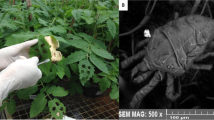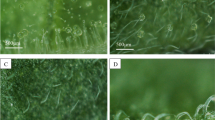Abstract
In tomato, infestation by the natural population of the fruit borer, Heliothis armigera (Hubner), on number basis was positively correlated with infestation on weight basis. Infestation was negatively correlated with the number of flowers per inflorescence. Surface texture of calyx also affected the susceptibility of the genotype. Reducing sugars in fruits were positively correlated, while zinc and iron content in foliage and ascorbic acid contents in fruits were negatively correlated with degree of infestation. Coefficient of determination revealed that 87% variability in borer infestation was due to zinc, iron, ascorbic acid and reducing sugar content.
Résumé
Chez la tomate, l’infestation par (la chemille mineuse des fruits) H. armigera sur une base numérique était corrélée positivement avec l’infestation sur une base pondérale. L’infestation était corrélée négativement avec le nombre de fleurs par inflorescence. La dureté du Calice affectait également la sensibilité du génotype. La teneur en sucres réducteurs était corrélée positivement, alors que les teneurs en zinc et fer dans les feuilles et en acide ascorbique dans les fruits étaient corrélées négativement avec l’infestation. Le coefficient de détermination a révélé que 87% de la variabilité dans l’infestation par cet insecte était due aux teneurs en zinc, en fer, en acide ascorbique et en sucres réducteurs.
Similar content being viewed by others
References
Angelini, A., Kammacher, P., Poisson C. and Vandamme P. (1982) Note preliminaire sur l’interest d’um caractere de bractee strophice chez le cotonnier. Cott. Fib. Trop. 20, 461–464.
AOAC (1970) Official methods of analysis of the association of Official Agricultural Chemists. 10th Ed. Washington D.C. pp. 1094.
Campbell B. C. and Duffey S. S. (1979) Tomatine and parasitic wasps: Potential incompatibility of plant antibiosis with biological control. Science 205, 700–702.
Canerday T. D., Todd J. N. and Dilbeck J. D. (1969) Evaluation of tomato for fruitworm resistance. J. Georgia ent. Soc. 4(2), 51–54.
Fery R. L. and Cuthbert F. P. Jr. (1973) Factors affecting evaluation of fruit worm resistance in the tomato. J. Amer. Soc. Hort. Sci. 98(5), 457–459.
Hiscox J. C. and Israelstam G. F. (1979) A method for the extraction of chlorophyll from leaf tissue without maceration. Canadian J. Bot. 57, 1332–1334.
Hulmi A. C. and Narain R. (1931) The furicyanide method for the determination of reducing sugars. A modification of Hegedorn Jenson Hones Technique. Biochem. J. 25, 1051.
Isman M. B. and Duffey S. S. (1982) Phenolic compounds in foliage of commercial tomato cultivars as growth inhibitors to the fruit worm, Heliothis zea. J. Amer. Soc. Hort. Soc. 107(1), 167–170.
Jones D. B. (1931) Factors for converting percentages of nitrogen in foods and feeds into percentages of proteins. U.S.D.A. Circ. No. 183, 21.
Kashyap R. K. (1983) Studies on resistance behaviour of tomato genotypes against fruit borer, Heliothis armigera (Hubner). Ph.D thesis. Haryana Agricultural University Hisar (India) pp. 83.
Knapp J. L., Hedin P. A. and Straub R. W. (1965) Status of resistance of corn earworm. Proc. North Cent. Branch ent. Soc. Amer. 270, 95–98.
Knapp J. L., Hedin P. A. and Douglas W. A. (1966) A chemical analysis of corn silk from single crosses of dent corn rated as resistant, intermediate and susceptible to the corn earworm. J. econ. Ent. 59, 1062–1064.
Koenig R. A. and Johnson C. R. (1942) Colorimetric determination of phosphorus in biological materials. Ind. Enog. Chem. (Analst) 14, 155–156.
Lukefahr M. J. (1977) Varietal resistance to cotton insects. Proc. Beltwide cotton Prod. Res. Conf. pp. 236–237. National Cotton Council, Memphis, Tenn.
Lukefahr M. J. and Houghtaling J. E. (1969) Resistance of cotton strains with gossypol contents to Heliothis spp. J. econ. Ent. 62, 588–591.
Lukefahr M. J., Houghtaling J. E. and Grahm D. G. (1975) Suppression of Heliothis spp. with cottons containing combinations of resistant characters. J. econ. Ent. 68, 743–746.
Lukefahr M. J., Houghtaling J. E. and Grahaus H. M. (1971) Suppression of Heliothis populations with glabrous cotton strains. J. econ. Ent. 64, 486–488.
Maxwell F. G. (1977) Plant resistance to cotton insects. Bull. Ent. Soc. Amer. 23(3), 199–203.
Rambold H. and Winter E. (1981) The chemist’s role in host plant resistance studies. In: International Workshop on Heliothis Management (Session V) held at International Crop Research Institute for Semi Arid Tropics, Hyderabad (India).
Widstorm N. W., McMillian W. W. and Wiseman B. R. (1970) Resistance in corn to the corn earworm and the fall armyworm. IV. Earworm injury to corn inbreds related to climatic conditions and plant characteristics. J. econ. Ent. 63(3), 803–808.
Williams W. C., Kennedy G. G., Yamamoto R. T., Thacker J. D. and Bordner J. (1980). 2-tridecanone: a naturally occurring insecticide from the wild tomato Lycopersicon hirsutum f. glabratum. Science 207, 888–889.
Wiseman B. R., McMillian W. W. and Widstorm N. W. (1977) Feeding of corn earworm in the laboratory on excised silks of selected corn enteries, with notes on Orius insidiosus. Florida Ent. 59, 305.
Author information
Authors and Affiliations
Rights and permissions
About this article
Cite this article
Kashyap, R.K., Verma, A.N. Factors Imparting Resistance to Fruit Damage by Heliothis armigera (Hubner) in Some Tomato Phenotypes. Int J Trop Insect Sci 8, 111–114 (1987). https://doi.org/10.1017/S1742758400007086
Received:
Revised:
Published:
Issue Date:
DOI: https://doi.org/10.1017/S1742758400007086




